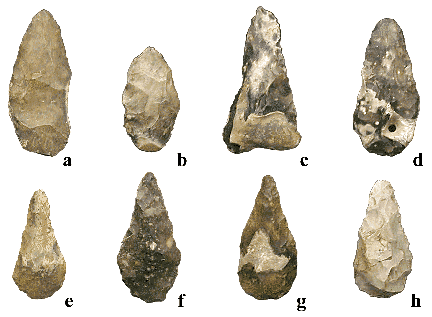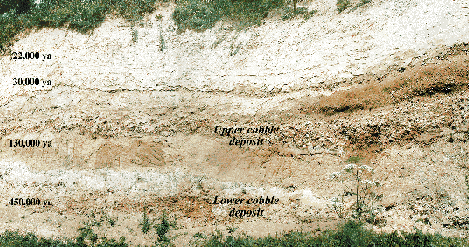|
The northern French village of Saint-Acheul along the River Somme near Amiens
is one of the original find sites of early bifacial or Mode 2 stone tool
industries, and is the type site of “Acheulean” bifaces whose oldest
known examples are from Konso-Gardula in Ethiopia (1.5 mya). The overall
time span of Acheulean technology, lasting until about 200,000 years ago,
is roughl y contemporary with that of Homo erectus and H.
Heidelbergensis, although Asian and European H. erectus evidently
did not use Mode 2 tools (Milliken 2004). While Saint-Acheul’s occupations of 450,000 BP and
after are relatively late in this sequence, as the type site of the Acheulean
handaxe (the key diagnostic element of Mode 2 lithic tools) it represents
a focal point of the first stages of archaeology in Europe. y contemporary with that of Homo erectus and H.
Heidelbergensis, although Asian and European H. erectus evidently
did not use Mode 2 tools (Milliken 2004). While Saint-Acheul’s occupations of 450,000 BP and
after are relatively late in this sequence, as the type site of the Acheulean
handaxe (the key diagnostic element of Mode 2 lithic tools) it represents
a focal point of the first stages of archaeology in Europe.
Fig.1: Jacques Boucher de Perthes (1788–1868). Initial
discoveries of stone tools in the Somme Valley around Saint-Acheul were made
in the 1830s and 40s by Jacques Boucher de Perthes (fig.1), a customs officer
in Abbeville who discovered quantities of “pre-Celtic” stone tools
and animal fossils from quarries near Abbeville, including the bifacially-worked
stones (fig.2) which he called haches antediluviennes
(“antediluvian axes”). B oucher de Perthes began publishing
and exhibiting these stone tools in Paris in 1838. A satisfactory explanation
of the stone tools found with fossils of extinct Pleistocene mammals, as
he stated in his 3-volume treatise Antiqués Celtiques et
Antédiluviennes (1848), demanded far more time depth than provided
by biblical interpretations. oucher de Perthes began publishing
and exhibiting these stone tools in Paris in 1838. A satisfactory explanation
of the stone tools found with fossils of extinct Pleistocene mammals, as
he stated in his 3-volume treatise Antiqués Celtiques et
Antédiluviennes (1848), demanded far more time depth than provided
by biblical interpretations.
Fig.2: Bifacial handaxes made from chert cobbles on upper Somme
terraces at Saint-Acheul (a-e) and Cagny (f-h) (Museé de Picardie,
Amiens; photo: Athena Review).
At first such claims met with derision from local scientists, many of whom
still believed fossil layers were relatively recent and caused by
“diluvial” catastrophes. But two geologists, Rigollot and Gaudry,
who successively dug at Saint-Acheul in order to disprove Boucher de
Perthes’ theories, ended up themselves finding flint tools associated
with extinct animal bones, and were converted to his views. These Somme valley
findings were paralleled by 1850-60s discoveries at Brixham Cave in Devon,
England where flint tools were similarly found with fossils of extinct lions, mammoths,
and wooly rhinoceroses (Daniel 1950).
Visitors today to the Saint-Acheul upper terrace exposures can see two main
layers of chert (flint) cobbles alternating with sandy silt (fig. 3). The
lower cobble deposits were exposed to the surface some 450,000 - 200,000
years ago, and at that time were extensively quarried for tool-making by
Lower Paleolithic inhabitants along the Somme.
Fig.3: Exposures of layers of alluvial cobbles in the ancient upper
terrace of the River Somme at Saint- Acheul. The lower levels dated ca. 450,000
-200,000 BP yielded Acheulean handaxes (photo: Athena Review).
References:
Daniel, G. 1950. A Hundred Years of Archaeology. London, Duckworth
Exhibition on Saint-Acheul in the Museé de Picardie in Amiens. France. Milliken, Sarah. 2004. The Colonization of Europe by Homo Erectus. Athena Review, vol.4, no.1 The
site of Saint-Acheul, near Amiens, France.
This article appears on page 22 in Vol.4, No.1 of Athena
Review.
.
|